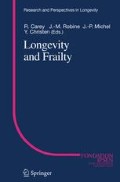Summary
Although we know that the number of nonagenarians and centenarians is rapidly increasing in low mortality countries, monitoring this development with accuracy remains difficult. Basic information on the number of centenarians comes from censuses. They make it possible to adjust annual population counts and to provide annual estimates of the number of centenarians, from which we can estimate the Centenarian Doubling Time (CDT). The registration of deaths, year after year, provides a much more accurate indication of the increase in the number of centenarians than do series of censuses. We propose that the Centenarian Rate (CR), i.e., the ratio of the number of centenarians to the number of people belonging to the same cohort — aged 60 years 40 years before — per 10,000 persons, allows us to assess the importance of the number of centenarians in many countries today with simple empirical data.
Access this chapter
Tax calculation will be finalised at checkout
Purchases are for personal use only
Preview
Unable to display preview. Download preview PDF.
References
Andrev KF (2002) Evolution of the Danish population from 1835 to 2000. Odense Monographs on Population Aging 9. Odense University Press.
Jansen F, Nusselder WJ, Looman CWN, Mackenbach JP, Kunst AE (2003) Stagnation in mortality decline among elders in the Netherlands. The Gerontologist 43(5): 722–734.
Jeune B (1995) In search of the first centenarians. In: Jeune B, Vaupel JW (eds) Exceptional longevity: from prehistory to the present. Odense Monographs on Population Aging 2. Odense University Press.
Nusselder WJ, Mackenbach JP (2000) Lack of improvement of life expectancy at advanced ages in the Netherlands. Intl J Epidemiol 29: 140–148.
Reidpath DD, Allotey P (2003) Infant mortality rate as indicator of population health. J Epidemiol Commun Health 57(5): 344–346.
Robine JM, Vaupel J (2001) Supercentenarians, slower ageing individuals or senile elderly? Exp Gerontol 36: 915–930.
Robine JM, Jagger C (2003) Acceleration of the rate of increase of centenarians: a comparison of England, France and Japan. PAA (au; please supply additional publication information paper presented at the annual meeting of the Population Association of America, 2003)
Robine JM, Saito Y (2003) Survival beyond age 100: The case of Japan. Pop Dev Rev 29 (suppl): 208–228.
Robine JM, Paccaud F (2005) Nonagerians and centernarians in Switzerland, 1860-2001: a demographic analysis. Epidemiol Community Health 59: 31–37
Robine JM, Saito Y, Jagger C (2003) The emergence of extremely old people: the case of Japan. Exp Gerontol 38: 735–739.
Robine JM, Caselli G (2005) Unprecedented increase in the number of centenarians. Genus, in press
Skytthe A, Jeune B (1995) Danish centenarians after 1800. In: Jeune B, Vaupel JW (eds) Exceptional longevity: from prehistory to the present. Odense Monographs on Population Aging 2. Odense University Press.
Vaupel JW, Jeune B (1995) The emergence and proliferation of centenarians. In: Jeune B, Vaupel JW (eds) Exceptional longevity: from prehistory to the present. Odense Monographs on Population Aging 2. Odense University Press.
Author information
Authors and Affiliations
Editor information
Editors and Affiliations
Rights and permissions
Copyright information
© 2005 Springer-Verlag Berlin Heidelberg
About this paper
Cite this paper
Robine, JM. (2005). The Oldest-Old: Emergence of a New Population. In: Carey, J.R., Robine, JM., Pierre Michel, J., Christen, Y. (eds) Longevity and Frailty. Research and Perspectives in Longevity. Springer, Berlin, Heidelberg. https://doi.org/10.1007/3-540-27388-3_13
Download citation
DOI: https://doi.org/10.1007/3-540-27388-3_13
Publisher Name: Springer, Berlin, Heidelberg
Print ISBN: 978-3-540-25153-8
Online ISBN: 978-3-540-27388-2
eBook Packages: Biomedical and Life SciencesBiomedical and Life Sciences (R0)

